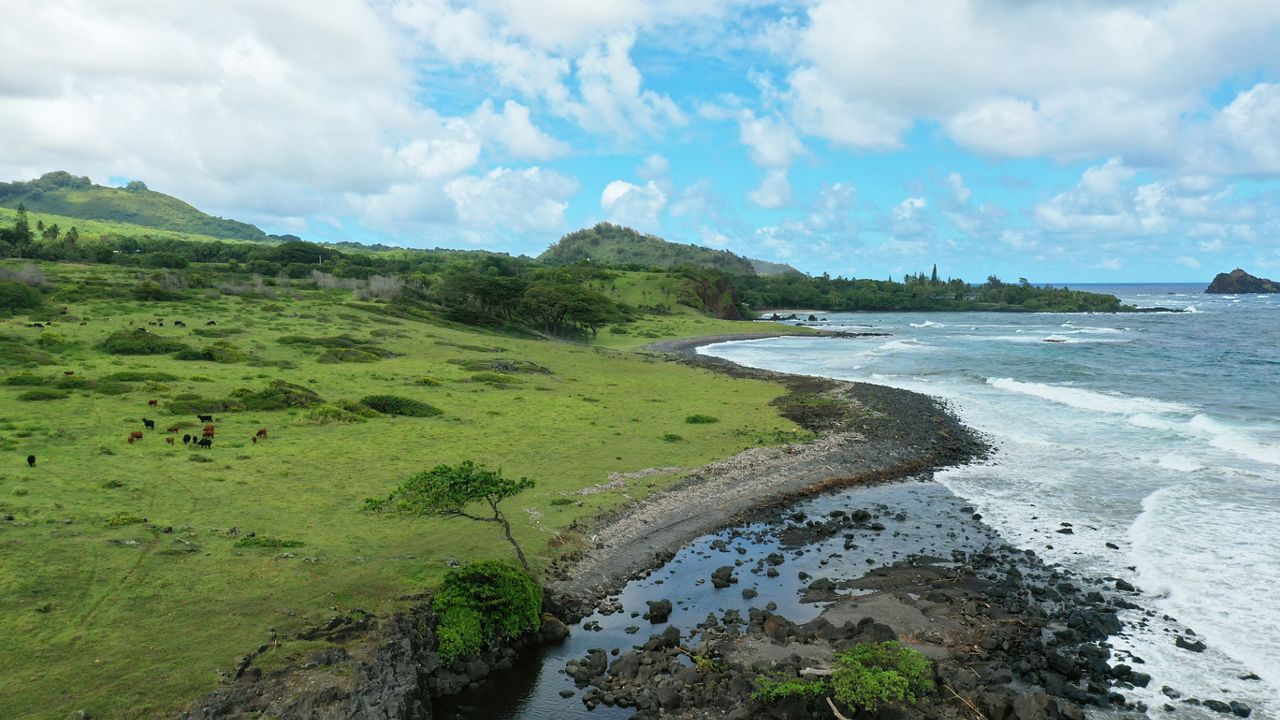MAUI — More than 30 acres at Makaalae on Maui’s Hana coast have been purchased for preservation.
Hana-based nonprofit Ke Ao Hāli‘i, Hawaii Land Trust, the state’s Department of Land and Natural Resources and the County of Maui worked together to purchase the land last month.
Ke Ao Hāli‘i purchased the 30 acres from Hana Ranch Partners for just over $3 million. The State Legacy Land Conservation Program contributed nearly $1.6 million, and the County of Maui’s Open Space Fund contributed $1.5 million, according to a release. A conservation easement co-held by HILT and Maui County will now permanently protect the land for future generations.
“Mahalo Ke Akua for helping us find the way and blessing us with purchasing this aina, and giving a chance for the descendants and community to malama this special place. Mahalo to the Hana community, all our supporters, the State of Hawaii, County of Maui and Hawaii Land Trust for protecting the land for future generations so our culture and way of life can be preserved,” said John (Irish) O’Hara, a lineal descendant and resident of Makaalae and vice-chair for Ke Ao Hāli‘i.
The land purchase marks the second phase of a four-phase plan that was developed in 2018. Once the fourth phase is completed, it will create a permanently protected 1.5-mile stretch of coastline and open land space from Hamoa Beach to Waioka Pond and Waihonu Stream.
Between these points, referred to as the Makaalae-Mokae lands, is an expanse of open space that holds the history of generations of Native Hawaiian people, families who have called this place home for generations and who live off the land just as their ancestors did. Some have left this isolated community, but many have stayed as well, raising their children, their grandchildren and the next instilling in them their family’s traditions, cultural practices and teaching them how to live sustainably within the area’s natural resources and how to protect it.
This is an area that also saw much change in land use from the commercial, export-based agriculture of sugar, cattle grazing (which is still present), tourism and property investments. Still, it remains the home of a local community with deep roots, one that came together to form Ke Ao Håli‘i, in order to protect the land, surrounding environment and its natural resources. The nonprofit serves as landowners and stewards of the Makaalae lands, and its board members have a special connection as they come from genealogical families from the area.
“Prior to ranching and plantation use, the cultural sites that remain in the area … are a top priority for the community and Hawaii Land Trust to protect and ensure pono (correct) ownership and stewardship (especially) because the iwi (the buried bones of ancestors) are needing to be repatriated and better cared for due to erosion issues,” said Shae Kamakaala, HILT’s director of aina protection. “Having that pono community ownership and stewardship in place provides a really good place to start.”
Hawaii Land Trust began conservation work in the area in 2002 when it acquired its first conservation easement by working together with landowner Hana Ranch Partners to protect 46 acres fronting Pohakuloa Bay at Makaalae. HILT then acquired two more conservation easements in 2014 that totaled 14 acres fronting Opau Bay at Makaalae.
In 2018, Ke Ao Hāli‘i was created by the Hana community with the mission to protect the remaining properties from Mokae to Makaalae. This is when the four-phase plan was created.
In 2020, the organization acquired 27 acres at Mokae with support from the State Legacy Land Program and the County of Maui’s Open Space Program. The acreage located within an area known as Kaholaiki, holds historic burial grounds and cultural sites; it also provides access for the community to pursue subsistence activities.
Now that the second phase is complete, the third phase of protecting 40 additional acres along the coast at Mokae is in the works. Ke Ao Hāli‘i and HILT are currently raising funds to complete the purchase in early 2022. They’re about $100,000 short of the purchase price and are looking toward private foundations, companies and individuals to help close the gap.
Once the third phase is completed, Hana Ranch Partners has committed to donating the remaining parcels that were protected earlier in conservation easements with Hawaii Land Trust to Ke Ao Hāli‘i. This will complete the acquisition and protection of the 152 acres of undeveloped lands located makai of Hana Highway.
Management of the land will fall under Ke Ao Hāli‘i, and the land will then be permanently protected through conservation easements prohibiting subdivision and development. The community will be able to access the area for cultural, subsistence, agricultural and recreational usage. The lands will be co-held and monitored by Hawaii Land Trust and Maui County for the future of the families who call this place home.
There are concerns about visitors accessing the area out of curiosity and unknowingly walking into sensitive cultural sites that are currently unmarked. Ke Ao Håli‘i is working on getting the necessary protections and signage to properly inform visitors of sites that are particularly vulnerable.
“I think it’s just being mindful of — and also understanding that the area holds important burial grounds,” said Kamakaala. “Ke Ao Hāli‘i holds monthly work days, so getting more information from their website on how to properly and appropriately engage with a place … that’s a good place to start. Join them for a work day and get to know the place alongside people who are from there and take care of it is such a positive way, an ideal way, to go out and visit.”



